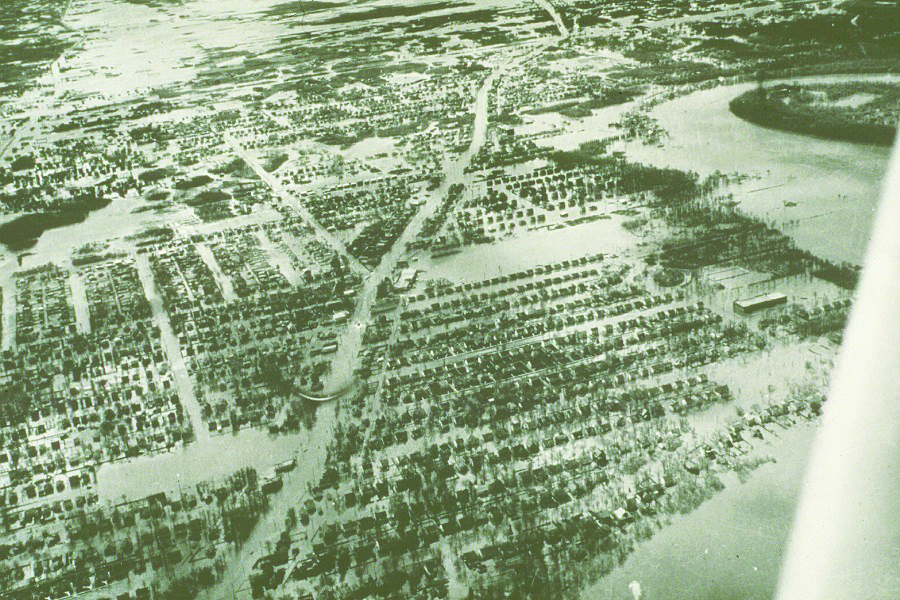by Bruce Cherney (Part 1)
With this year’s heavy snowfall, spring flooding in Manitoba has again become a concern. The Red River Basin Commission has said there will be some flooding, but they do not yet know the severity.
In 2011, the level of Lake Manitoba rose to record heights, affecting cottages, farms and nearby communities. Of course, many people also remember the 1997 flood, dubbed “the flood of the century.”
Although the 1997 flood was enormous, it was actually not the worst flood in recorded history. The flood of 1826 was 40 per cent greater than the “flood of the century” and nearly two metres higher than the destructive flood of 1950.
If a flood of the 1826 level was to be repeated today, the estimated damages would approach $5 billion. The floodway expansion is designed to protect the city from a flood of more than the 1826 magnitude.
Henry Youle Hind, writing on an expedition to the Red River, reported that floods had occurred in 1776, 1790, 1809, 1826 and 1852.
“In 1852, the Bishop of Rupert’s Land estimated the breadth of the inundated country to be about 12 miles a short distance below Fort Garry (Winnipeg),” wrote Hind. “Although the flood of 1852 was not so high as that of 1826, yet its effects were very severely felt in St. John’s and St. Paul’s parish and about Fort Garry.”
Just like 1997, the 1826 flood was preceded by the vast accumulation of snow in the Red River Valley and surrounding countryside. The 1997 flood was exasperated by a massive weekend blizzard at the beginning of April.
Also, the seeds of the 1826 were set a year earlier with flooding of the Red and Assiniboine rivers. The water remained high throughout the summer and the land became saturated by heavy rainfall.
Alexander Ross, a fur trader who retired to the Red River Settlement in 1825 and was an eyewitness to the flood of ’26, wrote in his book on the settlement of the “disastrous year 1826, one of the most fatal, both as to life and property, that ever befell Red River.”
The year had an inauspicious beginning, according to Ross, who said Metis buffalo hunters were starving on the plains. When Ross travelled to Pembina (North Dakota) in February, he found ample evidence of the plight of the hunters and assisted the Hudson’s Bay Company to convey food to the starving people.
It was reported that a December 1825 snow-storm “such as had not been witnessed for years” and lasting several days, “drove the buffalo herds beyond the hunters’ reach, and killed most of their horses.”
The blizzard scattered the hunters about the plains with the result that some were never found. “Families here, and families there, despairing of life, huddled themselves together for warmth, and, in too many cases, their shelter proved their grave.”
Ross said some people were found on the plains in a state of delirium as they tried to reach Pembina. He reported that a mother with a child on her back was found just a quarter mile from the safety of Pembina. “This poor creature must have travelled, at the least, 125 miles, in three days and nights, till she sunk at last in the too unequal struggle for life.
Others resorted to eating their “dogs, rawhide, leather and their very shoes.”
Ross said he encountered on the road from Pembina to Red River two people who had recently died, “and saw forty-two others, in seven or eight parties, crawling along with great difficulty.”
Ross could only provide a mouthful of bread to those he met on the road.
A family buried for several days in the snow was dug out. The father died, but the mother and her two children survived their ordeal.
The total of lives lost was 33, according to Ross.
“Hardly had the colonists recovered themselves, after these exertions, when they were visited by another great calamity.”
“By the end of April 1826, all the preconditions for a large flood had been fulfilled,” wrote Scott St. George and Bill Rainie in a 2002 paper on the causes of the flood published in the Canadian Water Resources Journal.
“Following a large flood in the spring of 1825, the available storage in the basin had been filled to capacity by an usually wet summer and fall ... general thawing at the settlement was delayed until April 12 and several heavy snowfalls between April 17 and April 26 added to the moisture stored in the basin. The arrival of thawing temperatures did not occur until the end of the month and break-up of the Red and Assiniboine rivers was the latest on record.”
Ross said snow depth averaged three feet on the plains and four to five feet in the woods. He called the cold “intense” because it often was -45°F (the celsius and fahrenheit scales converge at -40°).
Because of the bone-chilling cold, ice on the river reached 5-feet-7 in thickness (nearly two metres).
He said that the colonists were not alarmed that spring, which had arrived later than usual, until the flow of water increased when the high accumulations of snow began to melt.
Next week part 2



